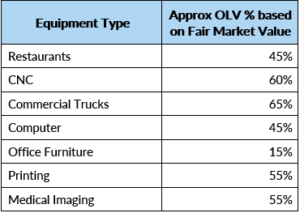22 Oct Equipment Liquidation Values: A Lender’s Perspective
How do you know what kind of value to expect for equipment or assets that are being liquidated? Depending on the circumstances surrounding the liquidation (and how fast you need it done) you will find yourself looking at very different forms of liquidation value.
Three Standards of Value
Liquidation value is the approximate dollar amount that a company’s assets could be sold for. What value you’ll get will be determined by the speed and condition under which you are selling the items. Three types of values can come into play: fair market value, forced liquidation value and orderly liquidation value.
What’s the difference?
Fair Market Value
You can think of this as the dealer price. If the equipment was bought on the open market for the best price possible, the seller would be receiving fair market value. Both the buyer and seller would have reasonable knowledge of relevant facts of the item, and neither would be under any compulsion to buy or sell.
Orderly Liquidation Value
The middle ground value – if you were able to sell your equipment over a reasonable period of time, approximately 90 to 180 days, this is the estimated gross amount you’d receive.
Forced Liquidation Value
Usually done at a public auction, this is the estimated gross amount you’d receive if you needed to sell equipment as soon as possible, approximately within 30 days.
When do you use each type of liquidation value?
The most common standard of value would be the Fair Market Value. This standard is not pertinent to lenders seeking to determine what they might recoup for the equipment in question during a liquidation; however, it is often referenced in a business valuation compiled for SBA purposes, when the net book value of equipment needs to be replaced with the appraised fair market value.
The unfortunate reality is that in coming months, lenders will be dealing with businesses that are in financial distress, facing closure or bankruptcy, all with an urgency to liquidate their collateral. In this case, Orderly Liquidation Value and Forced Liquidation Value will be most relevant. The difference between these values largely comes down to how much time you have to sell the asset.
Orderly liquidation value occupies a middle ground between fair market value and forced liquidation value. Neither immediate nor indefinite, orderly liquidation value is calculated with the understanding that a piece of equipment needs to be sold, but the owner can bear a longer timeline to make the sale. The orderly liquidation scenario is more like a “going out of business sale”, whereas a forced liquidation scenario is more like a bankruptcy auction.
The new SOP 50 10 6 (p. 257) cites the use of Orderly Liquidation Value when calculating the value of collateral for standard 7(a) Loans (excludes 7(a) Small Loans):
a) New machinery and equipment (excluding furniture and fixtures) may be valued at no more than 75% of price minus any prior liens for the calculation of “fully secured”;
b) Used or existing machinery and equipment (excluding furniture & fixtures) may be valued at no more than 50% of Net Book Value or 80% with an Orderly Liquidation Appraisal minus any prior liens for the calculation of “fully secured”;
…
d) Furniture and Fixtures may be valued at no more than 10% of Net Book Value or appraised [orderly liquidation] value.
Need a rough estimate on what to expect for an appraisal before getting a full work-up? Our team is here to help at no charge!
Here is a table that shows approximate values for some of the most popular types of equipment that we have appraised:

Place an order for a business valuation or equipment appraisal at www.reliantvalue.com/order.


